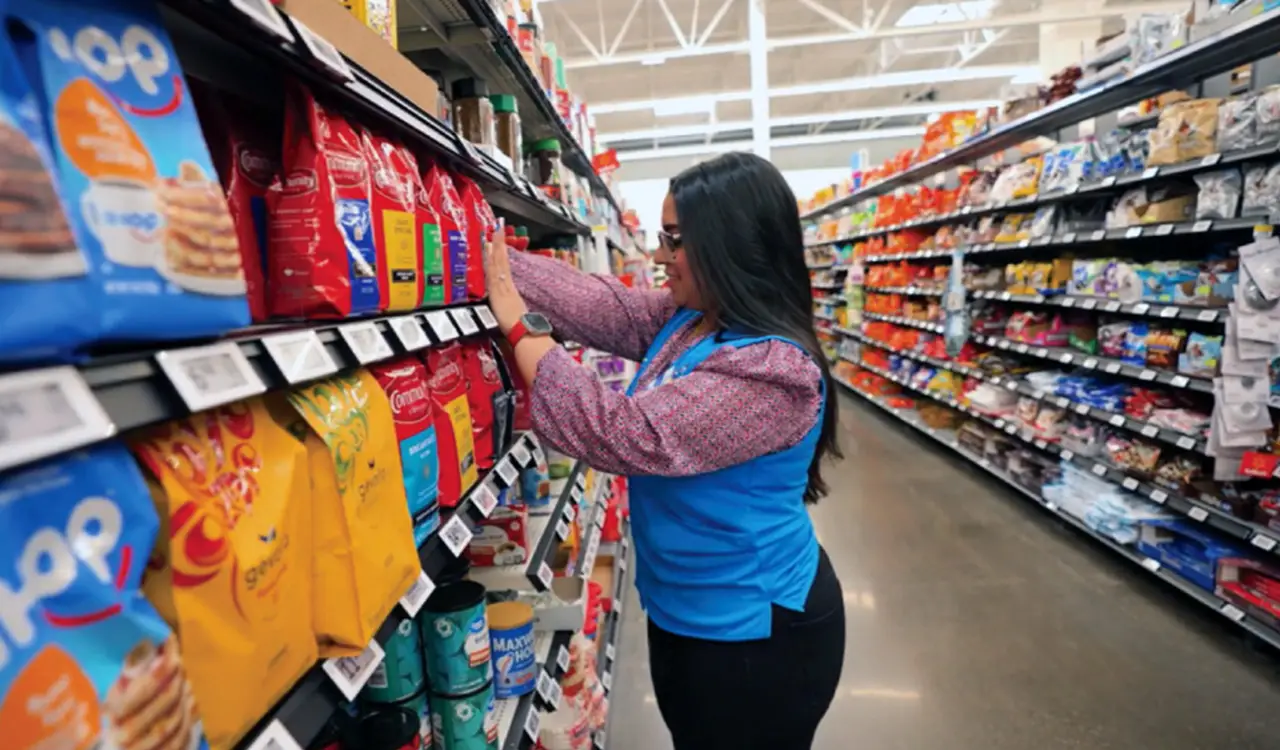Photo Credit: Walmart
In a bold move set to revolutionize the retail experience, Walmart has announced the rollout of electronic shelf labels (ESLs) in 2,300 stores across the United States by 2026. This marks a significant step towards the future of retail, promising a host of benefits for both the company and its customers, along with some potential downsides that could undermine consumer trust. These high-tech shelf tags from France-based VusionGroup will streamline operations and could enhance the shopping experience by providing dynamic pricing, nutritional information, sourcing details, and much more. But there’s also a downside.
ELS offer transparency that could foster trust between Walmart and its customers and attract younger more tech-savvy shoppers by reassuring them that the products they purchase meet the standards that are important to them. For Walmart, this level of transparency can differentiate its brand in a competitive market, appealing to socially conscious consumers who prioritize sustainability and ethical consumption — those Gen Zs, millennials, and incoming Alpha shoppers.
Dynamic Pricing
One of the most compelling advantages of electronic shelf labels for retailers is their capacity for dynamic pricing. In today’s world, prices are changing more rapidly than ever, the just released Jungle Scout Amazon’s Pricing Report 2024 reports that the number of categories on Amazon with an average product price increase during Q1 2024 was four times higher than in the same quarter last year. Great for Amazon, iffy for shoppers. On January 20th, Walmart told CBS MoneyWatch that it would not use the technology for dynamic or surge pricing.
The benefit for in-store retailers is that ESLs can be changed instantaneously from a central system, unlike traditional paper tags which require time and labor to update. This capability allows Walmart to respond swiftly to market trends, competitor pricing, and inventory levels. For example, if a competitor launches a sale, Walmart can adjust its prices in real time to stay competitive on a store-by-store basis. If certain perishable products (everything from groceries to health and beauty aids) are nearing their sell-by dates, prices can be reduced to encourage quick sales, thereby minimizing waste and maximizing revenue.
Where Walmart could enter murkier waters is when each store could price their goods differently — a higher income area might see higher prices than those who reside in mid-income areas. Higher prices in those stores where retailers have experienced higher-than-normal shrink – both from organized theft mobs as well as experiencing mounting losses from self-checkout fraud as more stores added self-checkout during the pandemic to offset labor shortages is also a possibility. On the plus side, dynamic pricing could benefit consumers by providing the most up-to-date information on discounts and special offers.
Shelf Talk
More than controversial dynamic pricing, ESL can benefit consumers who are increasingly interested in the nutritional content of the products they purchase. Walmart’s electronic shelf labels could play a pivotal role in providing detailed nutritional information directly at the point of sale, replacing those unappealing paper or plastic shelf danglers which scream out “diabetes-friendly and peanut free.” These digital tags can display calories, fat content, allergens, and other essential nutritional data, enabling shoppers to make discreet, informed decisions quickly and easily. For families with specific needs, such as gluten-free or low-sodium diets, this feature is particularly beneficial. Rather than scanning small print on packaging or searching online, customers can access all necessary information right on the shelf. Optimistically, this could encourage healthier eating habits by making nutritional information readily accessible and more accurate.
Gen Zs and millennials are increasingly concerned about where their food comes from; Walmart’s initiative could include sourcing details. Shoppers can learn about the origins of their produce, meat, and other grocery items, offering insights into farming practices, sustainability, and certifications like fair-trade and Kosher/Halal. A welcome benefit for many consumers.
This is the kind of transparency that could foster trust between Walmart and its customers and attract younger more tech-savvy shoppers by reassuring them that the products they purchase meet the standards that are important to them. For Walmart, this level of transparency can differentiate its brand in a competitive market, appealing to socially conscious consumers who prioritize sustainability and ethical consumption — those Gen Zs, millennials, and incoming Alpha shoppers.
Technical Glitches
While there is no doubt that ESLs could offer many benefits, there are also several potential downsides for retailers to be aware of. ESLs, like any digital technology, are susceptible to technical glitches and failures. If the system crashes or malfunctions, it can lead to incorrect pricing or missing information. In stealth mode, the implementation of ESLs could also sync up and involve the collection and analysis of customer data to tailor pricing and promotions. And we know that not all consumers have the same technological proficiency or trust in tech. The variations in the user experience, such as differences in how information is displayed or navigated on ESLs, can lead to inconsistent shopping experiences – an event that most retailers dread. For some shoppers, especially those with visual impairments or other disabilities, the accessibility and readability of ESLs might not match that of traditional labels. Let’s also remember that today there is a proliferation of screens in our daily lives, adding another fatiguing layer of digital interaction in the shopping environment which for some is already in overload mode.
Lack of Transparency
The biggest concern that I have is that dynamic pricing enabled by ESLs allows retailers to change prices rapidly in response to various factors. While this can benefit consumers through discounts and special offers, it can also lead to price manipulation and lack of transparency. In an era where shoppers are bombarded with headlines about retailers and CPG brands realizing record profits, astronomical CEO bonuses, and in some cases price gouging, consumer trust is already fragile at best. Imagine prices being increased during peak shopping hours or for items in high demand, which would further undermine consumer trust and confidence. These examples can lead to a disaster for a retailer. We all know how we feel when trying to book airfare or a ride share and observe when prices jump from one minute to the next.
All told Walmart’s rollout of electronic shelf labels is a clear indication of the digital direction in which retail is headed. The success or failure of ESLs will depend on just how consumers view this technology. Will they enjoy and value the plethora of valuable information? Or view it as a way for retailers to price gouge? It is a fragile balance.
If on a hot summer day, a retailer bumps up the price of a cold drink or ice cream there is little doubt in my mind that it will be the death knell for ESLs.





